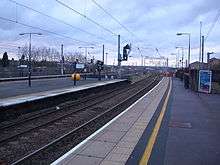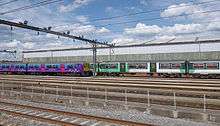Cricklewood railway station
| Cricklewood | |
|---|---|
|
Exterior of main station building at Cricklewood | |
 Cricklewood Location of Cricklewood in Greater London | |
| Location | Cricklewood |
| Local authority | London Borough of Barnet |
| Managed by | Thameslink |
| Station code | CRI |
| DfT category | E |
| Number of platforms | 4 |
| Fare zone | 3 |
| National Rail annual entry and exit | |
| 2010–11 |
|
| 2011–12 |
|
| 2012–13 |
|
| 2013–14 |
|
| 2014–15 |
|
| Key dates | |
| 1868 | Opened |
| Other information | |
| Lists of stations | |
| External links | |
| WGS84 | 51°33′31″N 0°12′46″W / 51.5586°N 0.2129°WCoordinates: 51°33′31″N 0°12′46″W / 51.5586°N 0.2129°W |
|
| |
Cricklewood railway station is in the London Borough of Barnet in north London. The station lies on the north-south Midland Main Line where it crosses Cricklewood Lane. It is served by Thameslink services on the cross-London Thameslink route. It is in London Travelcard Zone 3.
History

It was opened in 1868 as Childs Hill and Cricklewood when the Midland Railway built its extension (now called the Midland Main Line) to St. Pancras. The station acquired its present name in 1903.
To the north of the station, a motive power depot was built with a large roundhouse in 1882, with a second in 1893. With this was built a large marshalling yard and, in later years, LMS Garratts would be seen with their massive trains of coal from Toton in the Nottinghamshire and Derbyshire coalfields.[2]

A loop line, no longer in existence, was built heading north on the western side of the railway yard, then turning east underneath the main line at the viaduct over the River Brent (and also now the North Circular Road), then south on the eastern side. This obviously allowed trains to reverse direction, but also conveniently joined the railway yards on the two sides of the main lines.
Between 1899 and 1926, a number of proposals were put forward to build an underground railway along the Edgware Road from Central London to Cricklewood via Kilburn, and envisaged the construction of a Tube station at Cricklewood. None of the schemes succeeded and the line was never built.[3]
Services
Thameslink run 24-hour services on the Thameslink route. The typical off-peak service is four trains per hour southbound to London, Wimbledon and Sutton, and four trains per hour northbound, of which two terminate at St Albans and two at Luton. Thameslink services to and from Gatwick Airport, Three Bridges and Brighton stop here at night only, but pass through without stopping during the day. After midnight, an hourly service (not calling at Farringdon, City Thameslink or London Bridge) from Bedford to Three Bridges runs.[4]
East Midlands Trains InterCity services from Sheffield, Nottingham and Leicester run through at high speed on the Midland Main Line, but do not stop. Interchange with these services can be made at Luton and St Pancras International.
Development

Refurbishment of Cricklewood station has been carried out on the subway with cladding, lighting and a repaired floor. A renewed ticket office window with improved use for wheel chair and hearing impaired people. [5]
A new Brent Cross Thameslink station a little further north is proposed and the four platforms at Cricklewood station are not being extended from eight to 12 carriages. The other Thameslink stations north of the River Thames remaining with eight-car platform lengths are Hendon and Kentish Town. South of the River Thames Elephant & Castle southwards on the Thameslink suburban (Wimbledon/Sutton) loop, and on the Catford loop line towards Sevenoaks, will likewise remain eight-car stations. The Office of Rail Regulation has told Network Rail the procedure (using the Railways Act 1993) to close Cricklewood station if it was no longer viable following the construction of a proposed station at Brent Cross.[6] The developers of the Brent Cross Cricklewood development are planning to upgrade Cricklewood station [7] which they say would not happen if Cricklewood station were to close.[8] National and London government support for the new station was confirmed in March 2014.[9][10] The Brent Cross Cricklewood development project, as approved by Barnet Council, does include improving Cricklewood station's forecourt and providing step free access to all platforms.[11]
From March 2009, Southeastern and Thameslink began running some peak hour trains from Sevenoaks to Luton,[12] though in the off-peak these services turn back at Kentish Town.
Other trains from south of the River Thames within the larger Thameslink network may call at the station from 2015, when it is likely that the existing Sutton Loop trains will terminate at Blackfriars.[13]
In early 2008, the London Group of the Campaign for Better Transport published a proposal[14] for an off-road, mainly orbital North and West London Light railway (NWLLR), sharing the orbital Dudding Hill Line freight corridor, and taking over at least one of the two Midland Railway freight lines which run through Cricklewood station. If the scheme were to go ahead, it would provide one or maybe two extra light-rail platforms at the station.
Connections
London Buses routes 189, 226, 245, 260, 460 and C11 serve the station.
Cricklewood TMD and sidings


The original Cricklewood railway engine servicing depot was built by the Midland Railway just to the north west of curve of the junction with the Dudding Hill Line. It was built as and remains as the first major servicing depot for trains terminating in London, and for servicing the local regional commuter trains on the Midland Main Line. Part rebuilt by British Railways, it was closed to steam in December 1964.[15]
To the eastern side of the mainline, the Midland Railway had originally built a goods yard, which developed into a sizeable freight facility under British Railways, for collating and distributing goods around London. Resultantly, as the confines of the original depot with the introduction of electrification meant it could no longer be used, a new depot was built to the north east of the mainline, located directly north of the sidings and above the northern junction with the Dudding Hill Line.
Today, the depot serves as the London base for East Midland Trains, providing stabling and operational servicing for both its InterCity 125 8-coach sets and 5-coach Class 222. It also formerly served as a regional depot for First Capital Connect, until they were replaced by Thameslink and Great Northern in September 2014, who use other newly-built facilities in other locations. The sidings located to its south still provide freight services, including being the starting point for one of the daily BinLiner domestic waste trains that terminate at the Calvert Landfill site, operated by the Waste Recycling Group for the Department of the Environment.
Service pattern
| Preceding station | |
Following station | ||
|---|---|---|---|---|
| Hendon | Thameslink Thameslink |
West Hampstead Thameslink | ||
| Disused railways | ||||
| Welsh Harp Line open, station closed |
Midland Railway Midland Main Line |
West Hampstead Line and station open | ||
| Dudding Hill Line open (freight only), station closed |
Midland Railway Dudding Hill Line |
|||
References
| Wikimedia Commons has media related to Cricklewood railway station. |
- 1 2 3 4 5 "Station usage estimates". Rail statistics. Office of Rail Regulation. Please note: Some methodology may vary year on year.
- ↑ Radford, B., (1983) Midland Line Memories: a Pictorial History of the Midland Railway Main Line Between London (St Pancras) & Derby London: Bloomsbury Books
- ↑ Badsey-Ellis, Antony (2005). London's Lost Tube Schemes. Capital Transport. ISBN 1-85414-293-3.
- ↑ First Capital Connect: Thameslink Route Timetable B Retrieved 24 August 2013
- ↑ http://www.firstcapitalconnect.co.uk/better-stations/cricklewood/ Cricklewood Station Improvements
- ↑ "Decision... for the proposed disposal of network rail owned land: Cricklewood, London Borough of Barnet" (PDF). Office of Rail Regulation. Retrieved 23 January 2014.
- ↑ Brent Cross Cricklewood: The benefits Accessed 20 December 2010
- ↑ Brent Cross Cricklewood: Myths about the project Accessed 20 December 2010
- ↑ "Budget 2014: London regeneration and housing plans". BBC. 19 March 2014. Retrieved 26 July 2014.
- ↑ "Mayor welcomes Budget that sparks thousands of new jobs and homes in London". London.gov.uk. Greater London Authority. Retrieved 26 July 2014.
- ↑ Brent Cross Cricklewood: Transport Plan (Phase 2) Accessed 26 July 2013
- ↑ Train Times - Thameslink Route (PDF). First Capital Connect. March–May 2009. p. 52. Retrieved 2009-03-16.
- ↑ "Thameslink Programme - FAQ". Retrieved 21 November 2008.
- ↑ London Campaign for Better Transport North and West London light railway (NWLLR) / Brent Cross Railway (BCR) plan
- ↑ http://www.railuk.info/steam/getshed.php?id=80
- Butt, R. V. J. (1995). The Directory of Railway Stations: details every public and private passenger station, halt, platform and stopping place, past and present (1st ed.). Sparkford: Patrick Stephens Ltd. ISBN 1-8526-0508-1. OCLC 60251199.
